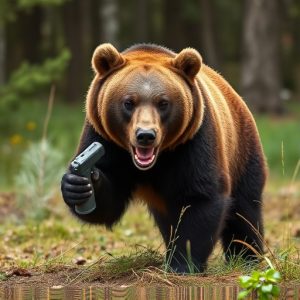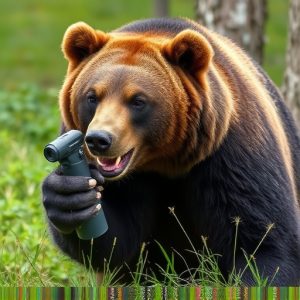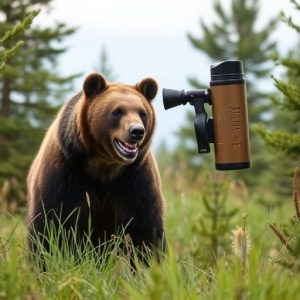Maximize Bear Spray Range: Optimize Application & Wind Direction for Safety
Maximizing bear spray safety requires understanding wind direction for optimal application. Aim spra…….
Maximizing bear spray safety requires understanding wind direction for optimal application. Aim spray away from yourself and towards bears, considering wind speed and direction. Use quick bursts at 20-30 feet distance to cover face and eyes of bears. Avoid spraying into direct or reverse winds to prevent self-exposure or premature dispersion. Proper training and awareness ensure enhanced safety in bear country.
In areas where bears roam, knowing how to deter these majestic yet potentially dangerous animals is crucial. Bear deterrent spray has emerged as a popular tool for personal protection in outdoor settings. This article delves into the science behind bear behavior and spray efficacy, offers insights on choosing the right product, and provides an optimal application guide. Additionally, we explore the impact of wind direction on bear spray safety, ensuring readers are equipped with the knowledge to navigate potential encounters effectively.
- Understanding Bear Behavior and Spray Efficacy
- Choosing the Right Bear Deterrent Spray: Factors to Consider
- Optimal Application Technique for Maximum Range and Protection
- Wind Direction and Bear Spray Safety: Navigating for Best Results
Understanding Bear Behavior and Spray Efficacy
Understanding bear behavior is key to knowing how and when to use bear deterrent spray effectively. Bears, especially grizzly bears, have a keen sense of smell and can detect chemicals from great distances. Therefore, it’s crucial to consider the wind direction before spraying – always aim away from yourself and towards the potential bear’s path of travel. This strategic application ensures maximum range protection without risking exposure to the spray yourself.
Bear spray is highly effective in deterring bears when used correctly. It creates a barrier of odor that can temporarily stun a bear, giving you time to retreat safely. However, factors like wind speed and direction, as well as the spray’s concentration and application technique, all play significant roles in its efficacy. Bear spray safety means understanding these variables and using the product responsibly to ensure your protection in bear country.
Choosing the Right Bear Deterrent Spray: Factors to Consider
When selecting a bear deterrent spray, several key factors come into play to ensure maximum effectiveness and safety. One of the most critical considerations is understanding the wind direction. Bear sprays are designed to create a barrier of odor and aerosol that deters bears when they detect the strong scent. However, the spray’s range and coverage heavily depend on whether you’re facing into or with the wind. If using it against the wind, the spray pattern can be disrupted, potentially reducing its effectiveness. Conversely, applying it with the wind allows for a more even distribution, increasing the chances of successfully deterring an approaching bear.
Additionally, the range of bear deterrent sprays varies among brands and models, typically measured in feet. A longer range provides greater protection, especially in open areas or when hiking in grizzly country. Keep in mind that no spray can guarantee 100% protection, but choosing one with a suitable range for your intended environment is essential. Always follow safety guidelines, including keeping the spray readily accessible and ensuring proper training on its use.
Optimal Application Technique for Maximum Range and Protection
To achieve maximum range and protection from bear spray, proper application technique is crucial. First, always read and understand the product’s instructions before use. When spraying, take aim at the bear’s face and eyes, as this is where the spray will be most effective. The optimal distance to deploy the spray is typically between 20 to 30 feet (6 to 9 meters), depending on wind conditions.
Be mindful of the wind direction; it should be blowing away from you and the bear. This ensures that the spray does not blow back onto you or disperse too quickly, losing its impact. When applying bear spray, use quick, short bursts—about 2 to 3 seconds—and move your body slightly to ensure even distribution of the aerosol. Following this technique will enhance your safety in bear country and maximize the protection offered by the spray.
Wind Direction and Bear Spray Safety: Navigating for Best Results
When using bear deterrent spray, understanding wind direction is crucial for optimal safety and effectiveness. Before applying the spray, assess the wind speed and direction. Ideal conditions are when the wind is blowing away from you, ensuring that any sprayed particles don’t return to your face or body. If the wind is coming directly at you or blowing back towards you, it’s best to avoid using the spray until conditions are more favorable.
Knowing bear spray safety guidelines in relation to wind direction allows for better navigation and protection. Always keep bears in your sight and be prepared to move if needed after spraying. Move away from the potential bear encounter area at an angle, ensuring the wind continues to blow the spray particles away from you. This strategic navigation increases the likelihood of successful deterrence and minimizes any unwanted exposure to bear spray.
When it comes to bear spray safety, understanding wind direction is key. By knowing how wind patterns can affect the range and effectiveness of your bear deterrent spray, you can ensure optimal protection during outdoor activities in bear country. Navigating these factors allows for a more strategic approach, giving you peace of mind while enjoying nature’s beauty. Remember, proper application techniques and choosing the right product are equally vital to maximize the safety provided by bear spray.


